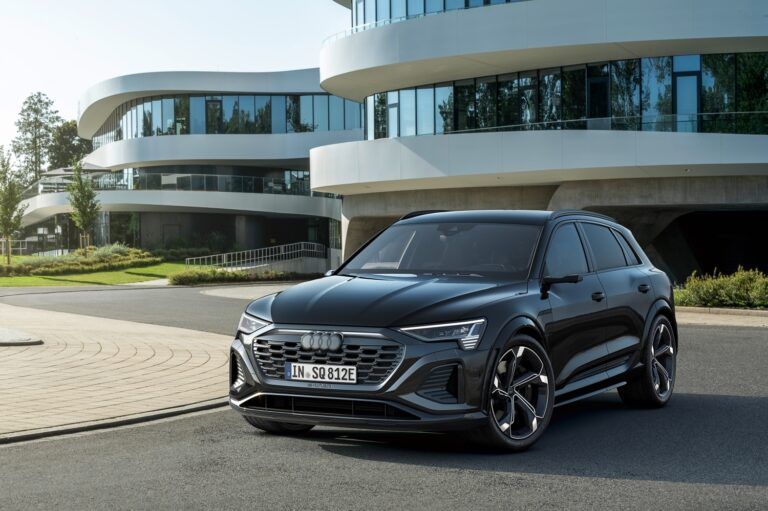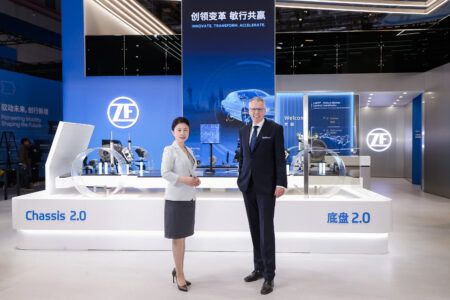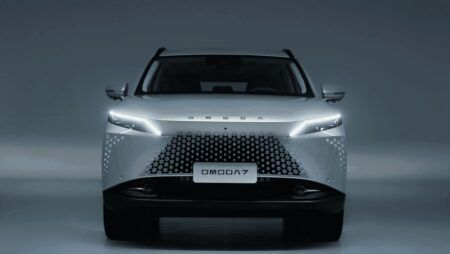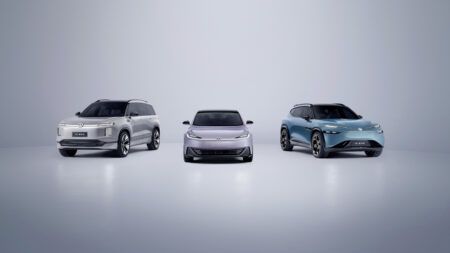First introduced in 2018, Audi has optimized the Q8 e-tron’s drivetrain, improved the aerodynamics, upgraded its charging capabilities, increased its battery capacity and extended its range.
Vehicle dimensions
As per the Worldwide Harmonised Light Vehicle Test Procedure (WLTP), the SUV’s range has been extended to 330 miles (541km), or 343 miles (552km) in the Sportback version. With a 2,928mm (2.93m) wheelbase and 569l of storage the Sportback is 4,915mm (4.9m) long, 1,937mm (1.94m) wide and and 1,619mm (1.42m) high for the Sportback (1.63m for the SUV). Its wheelbase of 2,928mm allows for plenty of legroom in the back seats too. It has a total storage volume of 631l.
“In the new Q8 e-tron, we were able to significantly increase both battery capacity and charging performance. This allowed us to achieve an optimal balance between energy density and charging capacity, as well as to increase efficiency,” said technical development officer Oliver Hoffmann.
Battery spec
The battery of the Q8 50 e-tron has a storage capacity of 89kWh (95kWh gross), while the more powerful versions of the Q8 55 e-tron and SQ8 e-tron boast a battery storage capacity of 106kWh (114kWh gross). At a high-powered charging station, the Audi Q8 50 e-tron reaches a maximum charging performance of 150kW. With the Q8 55 e-tron and SQ8 e-tron, the maximum charging performance increases to up to 170kW. The larger battery can be charged from 10 to 80 percent during a 31-minute charging stop, theoretically corresponding to a range of up to 240 miles (386km).
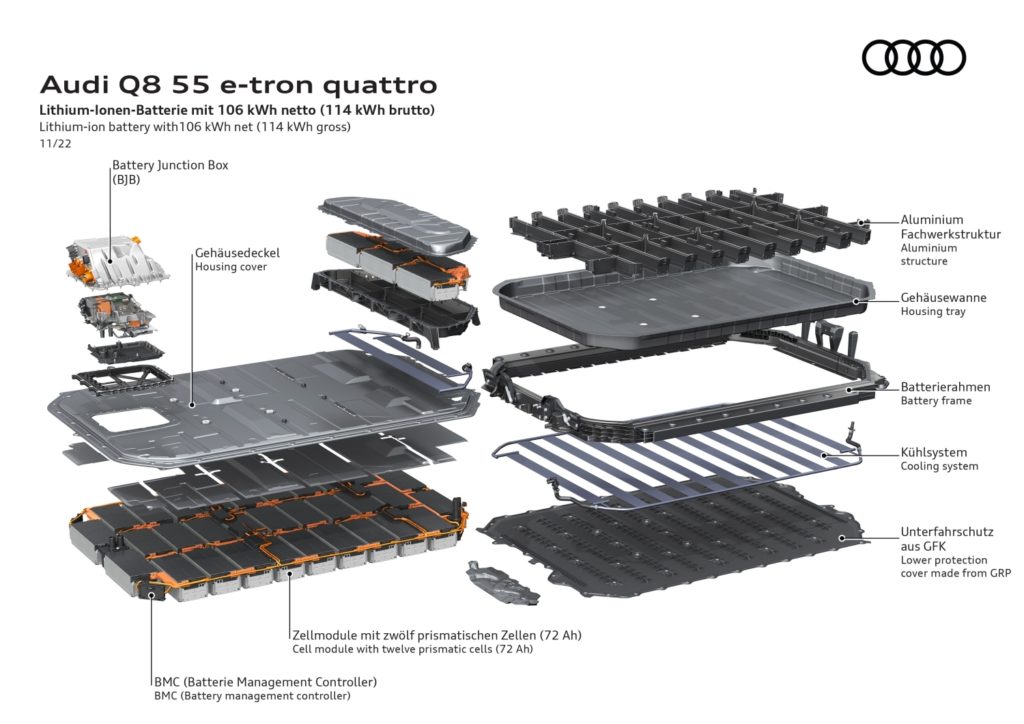
At an AC charging station or wallbox, the Audi Q8 e-tron charges at up to 11kW. Audi offers an optional AC charging upgrade of up to 22kW. Under ideal conditions, the Audi Q8 50 e-tron can completely charge in around nine hours and 15 minutes on a 11kW power source; four hours and 45 minutes on a 22kW power source. The Q8 55 e-tron’s larger battery will charge in around 11 hours, 30 minutes at 11 kW, and six hours at 22 kW.
Drivetrain triple threat
There are three drivetrain variants. Driven by two electric motors, the base models of the Audi Q8 50 e-tron and the Audi Q8 Sportback 50 e-tron generate 250kW (340PS) in boost mode and 664Nm of torque. Again driven by two electric motors, the Audi Q8 55 e-tron and Audi Q8 Sportback 55 e-tron generate 300kW (408PS) in boost mode and 664Nm of torque. Top speed is limited to 124mph (199km/h).
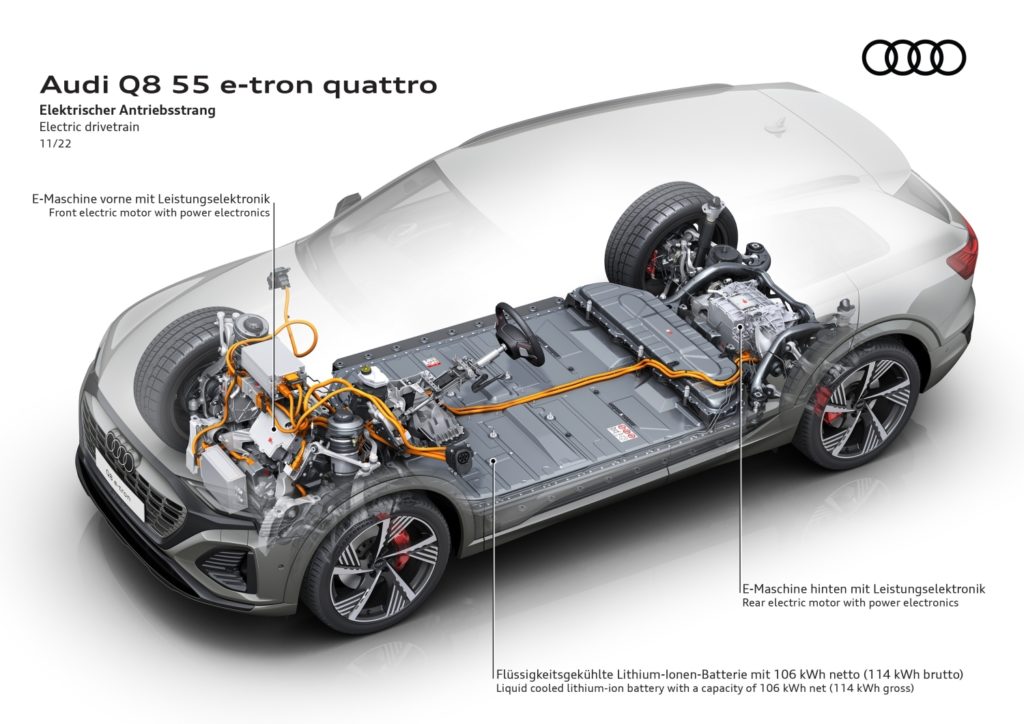
The top-end Audi SQ8 e-tron and Audi SQ8 Sportback e-tron are driven by three motors. Their boost performance amounts to 370 kW (503PS) and 973 Nm of torque. Top speed is limited to 130mph (209km/h).The three-motor set-up comprises a 124kW (168PS) electric motor on the front axle and two electric motors on the rear axle, each driving one wheel, with 98kW (133PS) of output. This allows for an output of up to 370kW (503PS) in boost mode.
Rear-axle revisions
The new Audi Q8 e-tron has two additional coils for the asynchronous motor on the rear axle, meaning there are now 14 coils generating an electromagnetic field.
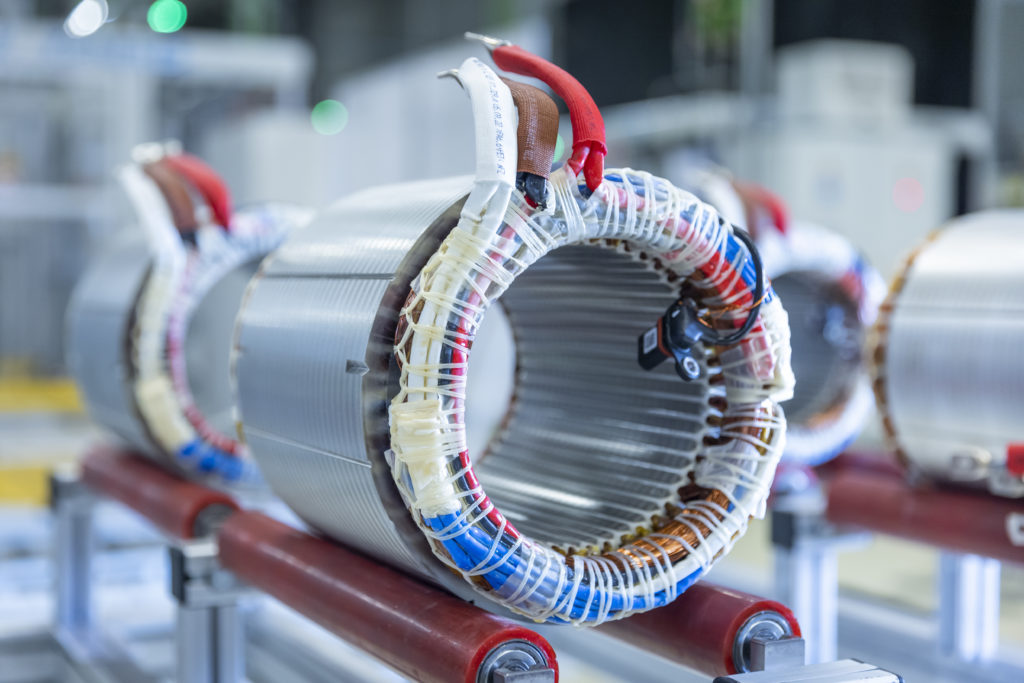
The motor consequently generates a stronger magnetic field with similar electricity input, which allows it to generate more torque. If this increase in torque is not required, the electric motor then consumes less energy to generate the required amount of torque. This lowers consumption and increases range.

Air-spring suspension, controlled shock absorption and progressive steering come as standard. The effect of the direct steering ratio is supported by more rigid suspension bearings on the front axle. Steering movements are thus transmitted to the wheels more directly, and feedback from steering reactions is improved as well, with adjustments also made to the chassis control systems.
Aerodynamics
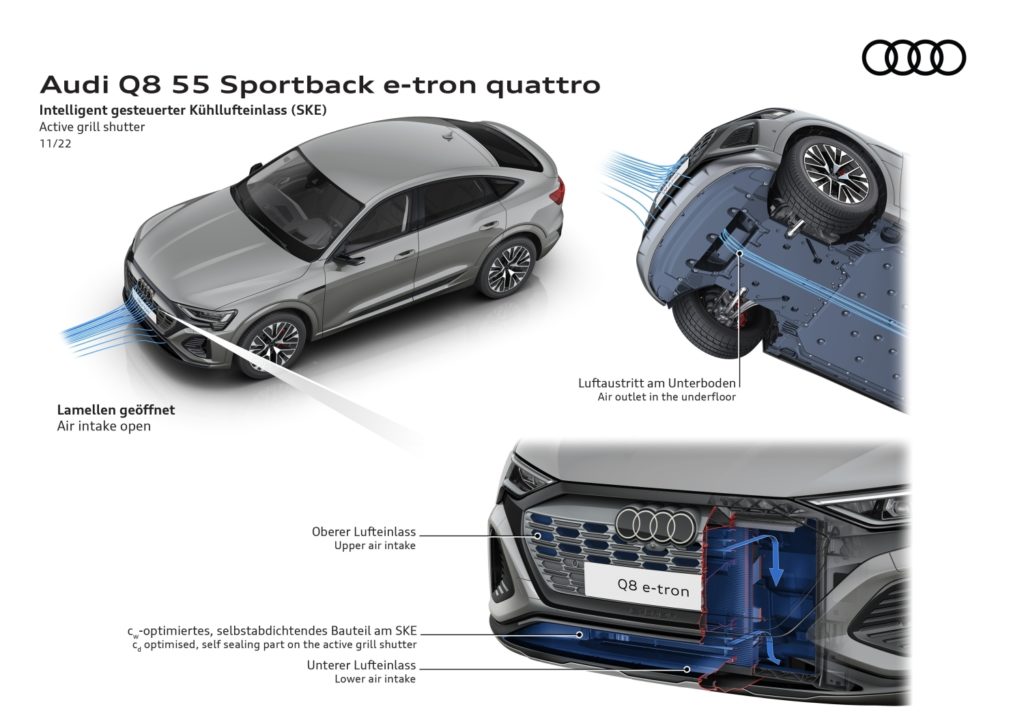
Audi has reduced the vehicles drag coefficient from 0.26 to 0.24 cw (Sportback) and from 0.28 to 0.26 cw (SUV). The wheel spoilers mounted on the underbody help divert airflow around the wheels. The spoilers on the front axle were enlarged, and the Audi Q8 Sportback e-tron now has spoilers on the rear wheels as well. With the SQ8 Sportback e-tron, spoilers are only mounted on the rear axle. This marks a first for Audi; a self-sealing system in addition to the electric shutters which will automatically close the radiator.
Safety and sustainability
The Audi Q8 e-tron will be certified as net-carbon- neutral for customers in Europe and the USA. Audi also uses recycled materials for some components in the Audi Q8 e-tron. These materials, treated through a recycling process, reduce the number of resources used and ensure a closed, efficient and sustainable material loop. In the interior of the Audi Q8 e-tron, Audi uses recycled materials for insulation and damping, as well as for carpeting. The decorative inlay above the display, called the Tech Layer, is available with a new anthracite-coloured technical material that’s partially composed of recycled PET bottles. On certain specifications, the sport seats are upholstered in synthetic leather and the microfiber material Dinamica. Dinamica is made from up to 45 percent polyester fibres that are manufactured from recycled PET bottles, used textiles and fibre residue. In contrast to previous microfiber quality, the production of Dinamica is also solvent-free.
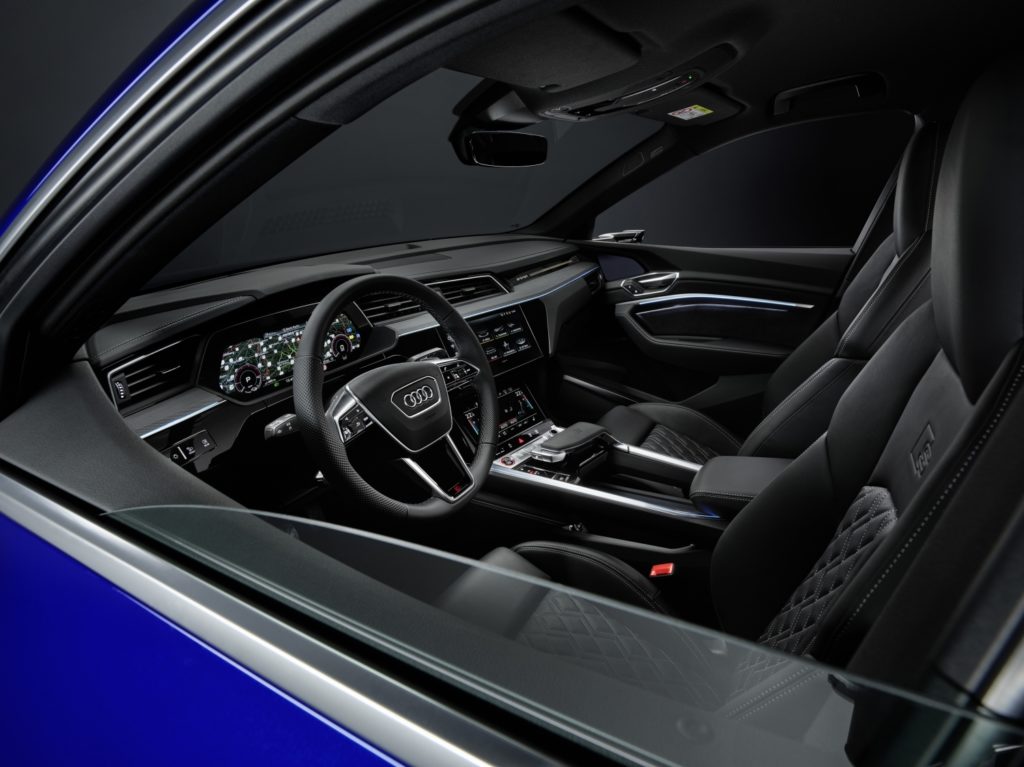
Some safety-related components that partially comprise mixed automotive plastic waste treated through a chemical recycling process are used for the first time – specifically, the plastic covers for the seatbelt buckles. As part of the PlasticLoop project, Audi worked with the plastics manufacturer LyondellBasell to establish a process in which chemical recycling will be used for the first time to reuse mixed automotive plastic waste in the series production of the Audi Q8 e-tron. In this process, jointly implemented with LyondellBasell, plastic components from customer vehicles that can no longer be repaired are dismantled and separated from foreign materials such as metal clips before being shredded and processed into pyrolysis oil through chemical recycling. This pyrolysis oil is then used as a raw material in the production of new plastics in a mass-balance approach.
Assistance at a touch
Like all luxury-class Audi models, the Q8 e-tron uses the MMI touch response operating system. Its two large high-resolution displays – the upper 10.1-inch display and the lower 8.6-inch display – replace nearly all conventional switches and knobs. Specific graphics show all the important aspects of electric driving, from charging performance to range. There are around 40 driver assistance systems available in the Audi Q8 e-tron. Up to five radar sensors, five cameras and 12 ultrasonic sensors provide environmental information that’s then analyzed by the central driver assistance control unit.
The Q8 e-tron is one of eight models in Audi’s electric portfolio, with expansion planned for the near future. “With our corporate strategy ‘Vorsprung 2030’, we’ve set a fixed date for our withdrawal from combustion engines and clearly decided that Audi will be a fully electric brand within 11 years,” said Markus Duesmann, chairman of the board of management of AUDI AG.


